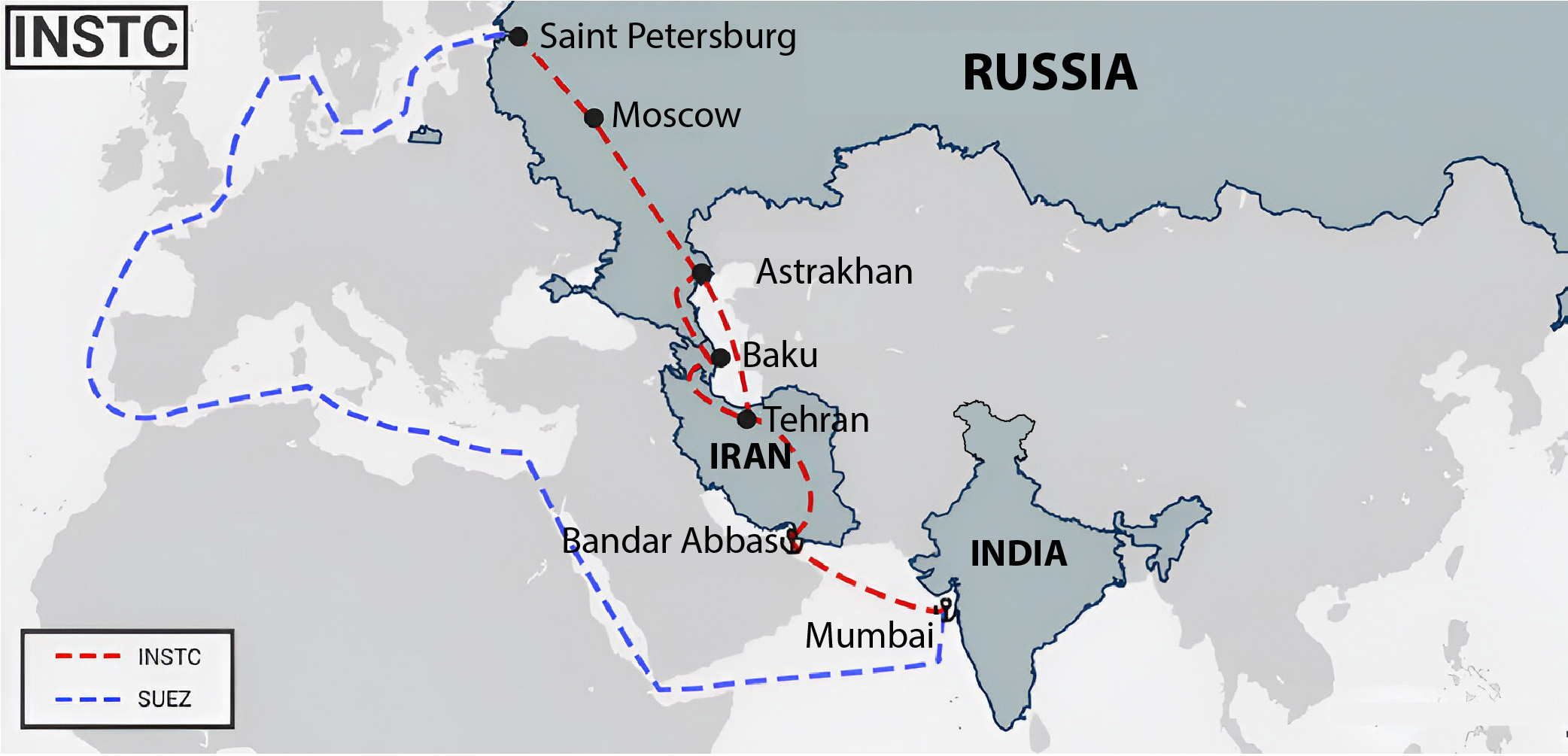International North South Transport Corridor (INSTC)
Vessel and container traffic increased via Chabahar Port and INSTC in FY24, as per Economic Survey 2024-25.
About INSTC

- 7,200-km Multi-modal transportation route linking Indian Ocean and Persian Gulf to Caspian Sea via Iran and onward to northern Europe via St. Petersburg in Russia.
- Established in 2000 in St. Petersburg, by Iran, Russia and India to enhance trade and transport connectivity among countries along its route.
- Currently, there are 13 Members of INSTC (India, Iran, Russia, Azerbaijan, Armenia, Kazakhstan, Kyrgyzstan, Tajikistan, Turkey, Ukraine, Belarus, Oman and Syria).
- Bulgaria has joined as an Observer State.
- Tags :
- International North-South Transport Corridor (INSTC)
Very Short-Range Air Defence System (VSHORADS)
DRDO has successfully conducted three successive flight-trials of VSHORADS from Chandipur off the coast of Odisha.
About Very Short-Range Air Defence System (VSHORADS)
- It is a man-portable air defence system and developed indigenously by Research Center Imarat, Hyderabad in collaboration with other DRDO laboratories.
- It is propelled by a dual thrust solid motor and meant for neutralizing low altitude aerial threats at short ranges.
- Its portability and rapid deployment capabilities make it a crucial asset for strengthening India's air defence.
- Tags :
- Air Defence System
- Very Short-Range Air Defence System (VSHORADS)
Samudrayaan Project
Samudrayaan project (under Deep Ocean Mission) has received Rs 600cr in Union Budget 2025-26.
About Samudrayaan Project
- Ministry: Ministry of Earth Sciences
- Aim: To develop a self-propelled manned submersible to carry 3 human beings to a water depth of 6000 meters for deep ocean exploration.
- To have an endurance of 12 hours of operational period and 96 hours in case of emergency.
- Period: 2020-2021 to 2025-2026
- Significance:
- Exploration: For biodiversity assessment, mineral resources like manganese, cobalt, copper, nickel, and other deep-sea deposits. Thus, contributing to Blue Economy.
- Research: Understanding chemosynthetic biodiversity in hydrothermal vents and methane seeps.
- Tags :
- Deep Ocean Mission
- Samudrayaan Project
Invasive Fish Species
NGT has sought a response from Centre on two invasive fish species being used as biological agents for controlling mosquitoes.
- Both are Least Concern (IUCN).
- Both tolerate brackish water, high salinities and temperatures.
About Gambusia Affinis (Western mosquitofish)
- Range: Mississippi River basin from central Indiana and Illinois, south to Gulf of Mexico.
- Characteristics:
- Found in freshwater; Survive in very low oxygen saturations.
- Viviparous and breeds throughout summer.
- Do not lay eggs, but rather give birth to live young.
- It was among the 100 world's "worst invasive alien species" by IUCN.
About Poecilia reticulata (Guppy, Millionfish and Rainbow fish)
- Range: Northern South America and Caribbean islands.
- Characteristics: Found in Shallow edges of pools and streams.
- Tags :
- Invasive Fish Species
- Western mosquitofish
- Millionfish and Rainbow fish
Bharatiya Bhasha Pustak Scheme
Finance Minister has introduced Bharatiya Bhasha Pustak Scheme in Union Budget 2025-26.
About Bharatiya Bhasha Pustak Scheme
- Aim: To provide digital form of Indian language books for schools and higher education to help students understand their subjects better.
- It is aligned with National Education Policy, 2020, wherein students across schools and universities will get textbooks, learning materials in digital formats.
- It also complements ASMITA (Augmenting Study Materials in Indian Languages through Translation and Academic Writing) initiative.
- It was launched by Ministry of Education and UGC in 2024 to develop 22,000 books in 22 Indian languages in next five years.
- Tags :
- NEP, 2020
- Bharatiya Bhasha Pustak Scheme
- ASMITA Initiative
Gene Bank for Crops Germplasm
Union Budget 2025-26 announced setting up of second National Gene Bank, comprising a million germplasm lines for future food and nutritional security.
- A gene bank is a repository of genetic material, such as seeds, pollen or tissue samples to protect them from potential extinction.
About First National Gene Bank
- First National Gene Bank was set up in 1996 by the Indian Council of Agricultural Research-National Bureau of Plant Genetic Resources (ICAR-NBPGR) in New Delhi.
- This bank comprises 12 regional stations across the country for collection and storage of vital crop germplasms.
- These germplasms are the genetic constituents of plants or animals that are used in research, conservation and crop breeding.
- Tags :
- Gene Bank
- Germplasm
Ocean Coordination Mechanism (OCM)
The Intergovernmental Oceanographic Commission of UNESCO (UNESCO-IOC) signs MoU to establish Ocean Coordination Mechanism for Wider Caribbean Region
About OCM:
- Aim: Securing a sustainable future for the Wider Caribbean region’s marine ecosystems.
- Funding: Will receive funding from Global Environment Facility (GEF).
- Functions:
- Promoting regional cooperation among Signatories for sustainable use of marine resources.
- sustainable development of Blue economy and effective use of limited resources for marine and coastal development.
- It comprises an Executive group of the International Organization and a Steering Group of Countries.
- Tags :
- Ocean Coordination Mechanism
- IOC-UNESCO



